
Digital design with CPLD applications and VHDL (R. Dueck, 2000)
.pdf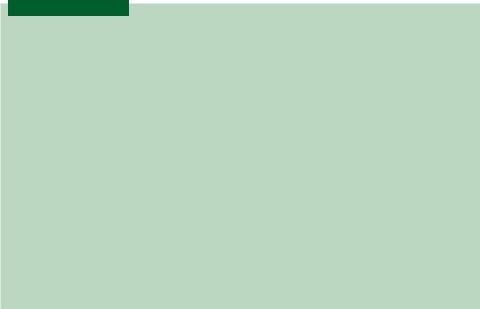
90 C H A P T E R 3 • Boolean Algebra and Combinational Logic
3.5 Simplification by the Karnaugh Map Method
K E Y T E R M S
Karnaugh map A graphical tool for finding the maximum SOP or POS simplification of a Boolean expression. A Karnaugh map works by arranging the terms of an expression in such a way that variables can be canceled by grouping minterms or maxterms.
Cell The smallest unit of a Karnaugh map, corresponding to one line of a truth table. The input variables are the cell’s coordinates, and the output variable is the cell’s contents.
Adjacent cell Two cells are adjacent if there is only one variable that is different
between the coordinates of the two cells. For example, the cells for minterms ABC and ABC are adjacent.
Pair A group of two adjacent cells in a Karnaugh map. A pair cancels one variable in a K-map simplification.
Quad A group of four adjacent cells in a Karnaugh map. A quad cancels two variables in a K-map simplification.
Octet A group of eight adjacent cells in a Karnaugh map. An octet cancels three variables in a K-map simplification.
In Example 3.14, we derived a sum-of-products Boolean expression from a truth table and simplified the expression by grouping minterms that differed by one variable. We made this task easier by breaking up the truth table into groups of four lines. (It is difficult for the eye to grasp an overall pattern in a group of 16 lines.) We chose groups of four because variables A and B are the same in any one group and variables C and D repeat the same binary sequence in each group. This allows us to see more easily when we have terms differing by only one variable.
The Karnaugh map, or K-map, is a graphical tool for simplifying Boolean expressions that uses a similar idea. A K-map is a square or rectangle divided into smaller squares called cells, each of which represents a line in the truth table of the Boolean expression to be mapped. Thus, the number of cells in a K-map is always a power of 2, usually 4, 8, or 16. The coordinates of each cell are the input variables of the truth table. The cell content is the value of the output variable on that line of the truth table. Figure 3.39 shows the formats of Karnaugh maps for Boolean expressions having two, three, and four variables, respectively.
There are two equivalent ways of labeling the cell coordinates: numerically or by true and complement variables. We will use the numerical labeling since it is always the same, regardless of the chosen variables.
The cells in the Karnaugh maps are set up so that the coordinates of any two adjacent cells differ by only one variable. By grouping adjacent cells according to specified rules, we can simplify a Boolean expression by canceling variables in their true and complement forms, much as we did algebraically in the previous section.
Two-Variable Map
Table 3.12 shows the truth table of a two-variable Boolean expression.
The Karnaugh map shown in Figure 3.40 is another way of showing the same information as the truth table. Every line in the truth table corresponds to a cell, or square, in the Karnaugh map.
The coordinates of each cell correspond to a unique combination of input variables (A, B). The content of the cell is the output value for that input combination. If the truth table output is 1 for a particular line, the content of the corresponding cell is also 1. If the output is 0, the cell content is 0.
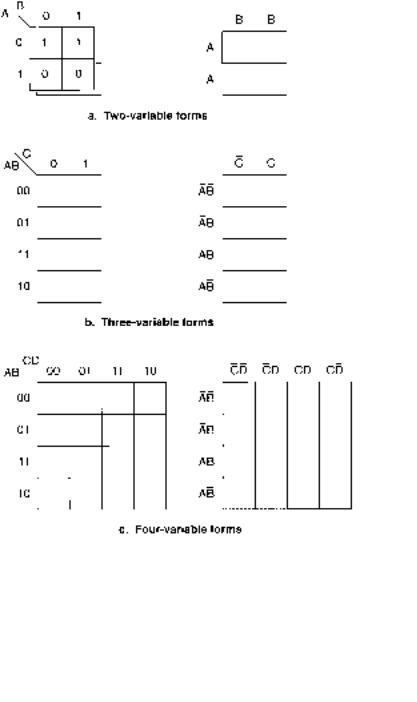
Table 3.12 Truth Table for a TwoVariable Boolean Expression
A |
B |
Y |
|
|
|
0 |
0 |
1 |
0 |
1 |
1 |
1 |
0 |
0 |
1 |
1 |
0 |
|
|
|
3.5 • Simplification by the Karnaugh Map Method |
91 |
FIGURE 3.39
Karnaugh Map Formats
FIGURE 3.40
Karnaugh Map for Table 3.12
The SOP expression of the truth table is
Y A B A B
which can be simplified as follows:
Y A (B B)
A
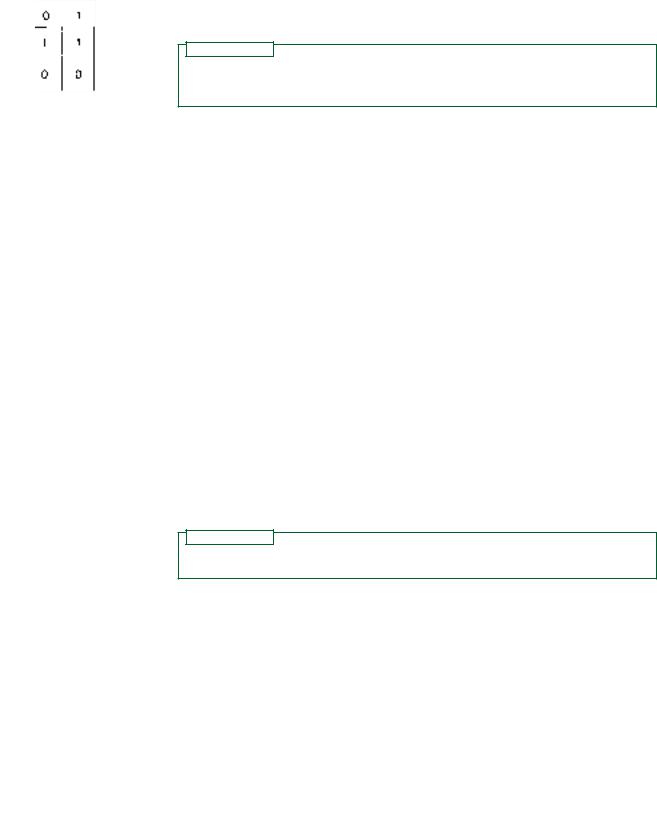
92 C H A P T E R 3 • Boolean Algebra and Combinational Logic
We can perform the same simplification by grouping the adjacent pair of 1s in the
Karnaugh map, as shown in Figure 3.41.
N O T E
When we circle a pair of 1s in a K-map, we are grouping the common variable in two minterms, then factoring out and canceling the complements.
FIGURE 3.41
Grouping a Pair of Adjacent
Cells
To find the simplified form of the Boolean expression represented in the K-map, we examine the coordinates of all the cells in the circled group. We retain coordinate variables that are the same in all cells and eliminate coordinate variables that are different in different cells.
In this case:
A is a coordinate of both cells of the circled pair. (Keep A.)
B is a coordinate of one cell of the circled pair, and B is a coordinate of the other. (Discard B/B.)
Y A
FIGURE 3.42
Quad
FIGURE 3.43
Octet
Threeand Four-Variable Maps
Refer to the forms of threeand four-variable Karnaugh maps shown in Figure 3.39. Each cell is specified by a unique combination of binary variables. This implies that the three-variable map has 8 cells (since 23 8) and the four-variable map has 16 cells (since 24 16).
The variables specifying the row (both maps) or the column (the four-variable map) do not progress in binary order; they advance such that there is only one change of variable per row or column. For example, the numbering of the rows is 00, 01, 11, 10, rather than the binary order 00, 01, 10, 11. If we were to use binary order, adjacent cells in rows 2 and 3 or 3 and 4 would differ by two variables, meaning we could not factor out and cancel a pair of complements by grouping these cells. For instance, we cannot cancel complementary variables from the pair A B C A B C, which differs by two variables.
N O T E
The number of cells in a group must be a power of 2, such as 1, 2, 4, 8, or 16.
A group of four adjacent cells is called a quad. Figure 3.42 shows a Karnaugh map for a Boolean function whose terms can be grouped in a quad. The Boolean expression displayed in the K-map is:
Y A B C A B C A B C A B C
A and B are both part of the quad coordinates in true and complement form. (Discard A and B.)
C is a coordinate of each cell in the quad. (Keep C.)
Y C
Grouping cells in a quad is equivalent to factoring two complementary pairs of variables and canceling them.
Y (A A)(B B)C C
You can verify that this is the same as the original expression by multiplying out the terms.
An octet is a group of eight adjacent cells. Figure 3.43 shows the Karnaugh map for the following Boolean expression:

3.5 • Simplification by the Karnaugh Map Method 93
Y A B C D A B C D A B C D A B C DA B C D A B C D A B C D A B C D
Variables A, C, and D are all coordinates of the octet cells in true and complement form. (Discard A, C, and D.)
B is a coordinate of each cell. (Keep B.)
Y B
The algebraic equivalent of this octet is an expression where three complementary variables are factored out and canceled.
Y (A A)B(C C)(D D) B
N O T E
A Karnaugh map completely filled with 1s implies that all input conditions yield an output of 1. For a Boolean expression Y, Y 1.
|
Grouping Cells Along Outside Edges |
|
The cells along an outside edge of a threeor four-variable map are adjacent to cells along |
|
the opposite edge (only one change of variable). Thus we can group cells “around the out- |
|
side” of the map to cancel variables. In the case of the four-variable map, we can also |
|
group the four corner cells as a quad, since they are all adjacent to one another. |
|
|
EXAMPLE 3.15 |
Use Karnaugh maps to simplify the following Boolean expressions: |
|
a. Y A B C A B C A B C A B C |
|
b. Y A B C D A B C D A B C D A B C D |
|
Solutions Figure 3.44 shows the Karnaugh maps for the Boolean expressions labeled a |
|
and b. Cells in each map are grouped in a quad. |
FIGURE 3.44 |
|
Example 3.15 |
|
K-Maps |
|
a.A and C are both coordinates of two cells in true form and two cells in complement
form. (Discard A and C.)
B is a coordinate of each cell. (Keep B.)
Y B
b.A and C are both coordinates of two cells in true form and two cells in complement
form. (Discard A and C.)
B and D are coordinates of each cell. (Keep B and D.)
Y B D
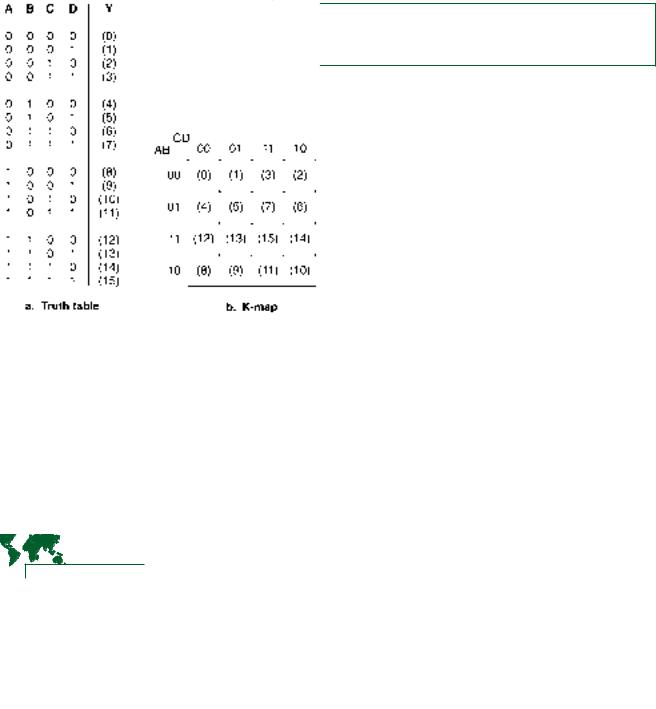
94 C H A P T E R 3 • Boolean Algebra and Combinational Logic
Loading a K-Map From a Truth Table
N O T E
We don’t need a Boolean expression to fill a Karnaugh map if we have the function’s truth table.
Figures 3.45 and 3.46 show truth table and Karnaugh map forms for threeand four-vari- able Boolean expressions. The numbers in parentheses show the order of terms in binary sequence for both forms.
The Karnaugh map is not laid out in the same order as the truth table. That is, it is not laid out in a binary sequence. This is due to the criterion for cell adjacency: no more than one variable change between rows or columns is permitted.
FIGURE 3.45
Order of Terms (Three-Variable
Function)
FIGURE 3.46
Order of Terms (Four-Variable
Function)
Filling in a Karnaugh map from a truth table is easy when you understand a system for doing it quickly. For the three-variable map, fill row 1, then row 2, skip to row 4, then go back to row 3. By doing this, you trace through the cells in binary order. Use the mnemonic phrase “1, 2, skip, back” to help you remember this.
The system for the four-variable map is similar but must account for the columns as well. The rows get filled in the same order as the three-variable map, but within each row, fill column 1, then column 2, skip to column 4, then go back to column 3. Again, “1, 2, skip, back.”

|
|
|
|
|
|
|
|
3.5 • Simplification by the Karnaugh Map Method |
95 |
|
|
|
The four-variable map is easier to fill from the truth table if we break up the truth table |
||||||
|
into groups of four lines, as we have done in Figure 3.46. Each group is one row in the Kar- |
||||||||
|
naugh map. Following this system will quickly fill the cells in binary order. |
|
|||||||
|
|
|
Go back and follow the order of terms on the four-variable map in Figure 3.46, using |
||||||
|
this system. (Remember, for both rows and columns, “1, 2, skip, back.”) |
|
|||||||
|
Multiple Groups |
|
|
||||||
|
|
|
|
|
|
|
|
|
|
|
|
|
N O T E |
|
|
|
|
|
|
|
|
|
If there is more than one group of 1s in a K-map simplification, each group is a |
|
|||||
|
|
|
term in the maximum SOP simplification of the mapped Boolean expression. The |
|
|||||
|
|
|
resulting terms are ORed together. |
|
|||||
|
|
|
|
|
|
||||
|
|
|
|
|
|
||||
EXAMPLE 3.17 |
Use the Karnaugh map method to simplify the Boolean function represented by Table 3.13. |
||||||||
|
Table 3.13 Truth Table for |
|
|
||||||
|
Example 4.3 |
|
|
|
|
|
|||
|
|
|
|
|
|
|
|
|
|
|
|
A |
B |
C |
D |
|
Y |
|
|
|
|
|
|
|
|
|
|
|
|
|
0 |
0 |
0 |
0 |
|
1 |
|
|
|
|
0 |
0 |
0 |
1 |
|
0 |
|
|
|
|
0 |
0 |
1 |
0 |
|
1 |
|
|
|
|
0 |
0 |
1 |
1 |
|
0 |
|
|
|
|
0 |
1 |
0 |
0 |
|
0 |
|
|
|
|
0 |
1 |
0 |
1 |
|
1 |
|
|
|
|
0 |
1 |
1 |
0 |
|
0 |
|
|
|
|
0 |
1 |
1 |
1 |
|
1 |
FIGURE 3.47 |
|
|
|
1 |
0 |
0 |
0 |
|
0 |
|
||
|
|
Example 3.17 |
|
||||||
|
1 |
0 |
0 |
1 |
|
0 |
|
||
|
|
K-Map |
|
||||||
|
1 |
0 |
1 |
0 |
|
0 |
|
||
|
|
|
|
||||||
|
1 |
0 |
1 |
1 |
|
0 |
|
|
|
|
1 |
1 |
0 |
0 |
|
0 |
|
|
|
|
1 |
1 |
0 |
1 |
|
1 |
|
|
|
|
1 |
1 |
1 |
0 |
|
0 |
|
|
|
|
1 |
1 |
1 |
1 |
|
1 |
|
|
|
|
|
|
|
|
|
|
|
|
|
Solution Figure 3.47 shows the Karnaugh map for the truth table in Table 3.14. There are two groups of 1s—a pair and a quad.
Pair:
Variables A, B, and D are coordinates of both cells. (Keep A B D.) C is a coordinate of one cell and C is a coordinate of the other. (Discard C.)
Term: A B D
Quad:
Both A and C are coordinates of two cells in true form and two cells in complement form. (Discard A and C.)
B and D are coordinates of all four cells. (Keep B D.) |
|
Term: B D |
|
Combine the terms in an OR function: |
|
Y A B D B D |
|
|

96 C H A P T E R 3 • Boolean Algebra and Combinational Logic
Overlapping Groups
N O T E
A cell may be grouped more than once. The only condition is that every group must have at least one cell that does not belong to any other group. Otherwise, redundant terms will result.
EXAMPLE 3.18
Table 3.14 |
Truth Table |
||
for Example 3.18 |
|
||
|
|
|
|
A |
B |
C |
Y |
|
|
|
|
0 |
0 |
0 |
1 |
0 |
0 |
1 |
1 |
0 |
1 |
0 |
0 |
0 |
1 |
1 |
1 |
1 |
0 |
0 |
0 |
1 |
0 |
1 |
0 |
1 |
1 |
0 |
1 |
1 |
1 |
1 |
1 |
|
|
|
|
Simplify the function represented by Table 3.14.
Solution The Karnaugh map for the function in Table 3.14 is shown in Figure 3.48, with two different groupings of terms.
FIGURE 3.48
Example 3.18
K-Maps
a. The simplified Boolean expression drawn from the first map has three terms.
Y A B A B B C
b. The second map yields an expression with four terms.
Y A B A B B C A C
One of the last two terms is redundant, since neither of the pairs corresponding to these terms has a cell belonging only to that pair. We could retain either pair of cells and its corresponding term, but not both.
We can show algebraically that the last term is redundant and thus make the expression the same as that in part a.
Y A B A B B C A C
A B A B B C A (B B) CA B A B B C A B C A B C
A B (1 C) A B B C (1 A)
A B A B B C
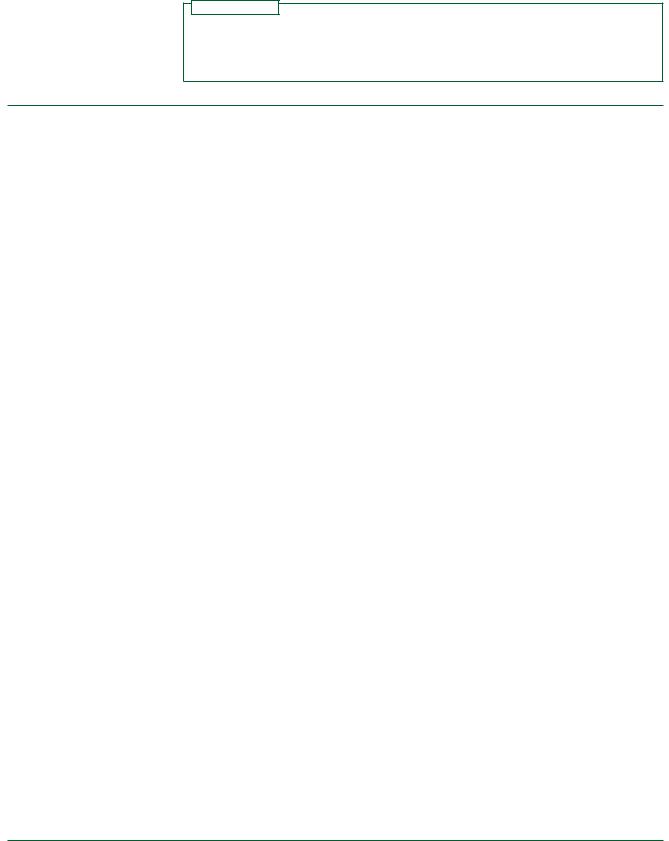
3.5 • Simplification by the Karnaugh Map Method |
97 |
Conditions for Maximum Simplification
N O T E
The maximum simplification of a Boolean expression is achieved only if the circled groups of cells in its K-map are as large as possible and there are as few groups as possible.
EXAMPLE 3.19
FIGURE 3.49
Example 3.19
K-Maps
Table 3.15 Truth Table for Example 3.19
A |
B |
C |
D |
Y |
|
|
|
|
|
0 |
0 |
0 |
0 |
1 |
0 |
0 |
0 |
1 |
1 |
0 |
0 |
1 |
0 |
1 |
0 |
0 |
1 |
1 |
1 |
0 |
1 |
0 |
0 |
0 |
0 |
1 |
0 |
1 |
1 |
0 |
1 |
1 |
0 |
0 |
0 |
1 |
1 |
1 |
1 |
1 |
0 |
0 |
0 |
1 |
1 |
0 |
0 |
1 |
1 |
1 |
0 |
1 |
0 |
1 |
1 |
0 |
1 |
1 |
1 |
1 |
1 |
0 |
0 |
0 |
1 |
1 |
0 |
1 |
1 |
1 |
1 |
1 |
0 |
0 |
1 |
1 |
1 |
1 |
1 |
|
|
|
|
|
Find the maximum SOP simplification of the Boolean function represented by Table 3.15.
Solution The values of Table 3.15 are loaded into the three K-maps shown in Figure 3.49. Three different ways of grouping adjacent cells are shown. One results in maximum simplification; the other two do not.
We get the maximum SOP simplification by grouping the two octets shown in Figure 3.49a. The resulting expression is
a. Y B D
Figures 3.49b and c show two simplifications that are less than the maximum because the chosen cell groups are smaller than they could be. The resulting expressions are:
b.Y A B A B D
c.Y B B D
Neither of these expressions is the simplest possible, since both can be reduced by Boolean algebra to the form in Figure 3.49a.
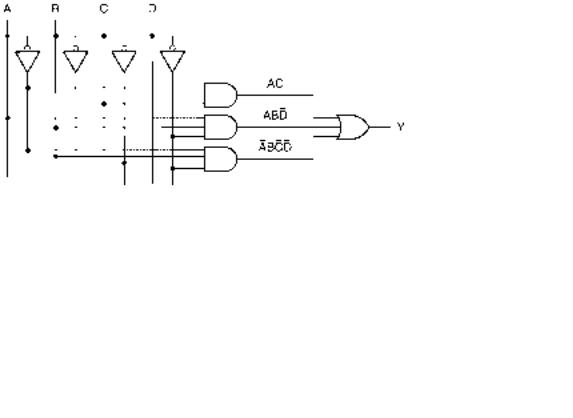
98 C H A P T E R 3 • Boolean Algebra and Combinational Logic
Using K-Maps for Partially Simplified Circuits
Figure 3.50 shows a logic diagram that can be further simplified. If we want to use a Karnaugh map for this process, we must do one of two things:
1.Fill in the K-map from the existing product terms. Each product term that is not a minterm will represent more than one cell in the Karnaugh map. When the map is filled, regroup the cells for maximum simplification.
2.Expand the sum-of-products expression of the circuit to get a sum-of-minterms form. Each minterm represents one cell in the K-map. Group the cells for maximum simplification.
FIGURE 3.50
Logic Diagram That Can Be
Further Simplified
FIGURE 3.51
Further Simplification of Logic Diagram (Figure 3.50)
Figure 3.51 shows the K-map derived from the existing circuit and the regrouped cells that yield the maximum simplification.
The algebraic method requires us to expand the existing Boolean expression to get a sum of minterms. The original expression is:
Y A B C D A B D A C
The theorem (x x) 1 implies that we can AND a variable with a term in true and complement form without changing the term. The expanded expression is:
Y A B C D A B (C C) D A (B B) C (D D)A B C D A B C D A B C D
A B C D A B C D A B C D A B C D
The terms of this expression can be loaded into a K-map and simplified, as shown in
Figure 3.51b. Figure 3.52 shows the logic diagram for the simplified expression.
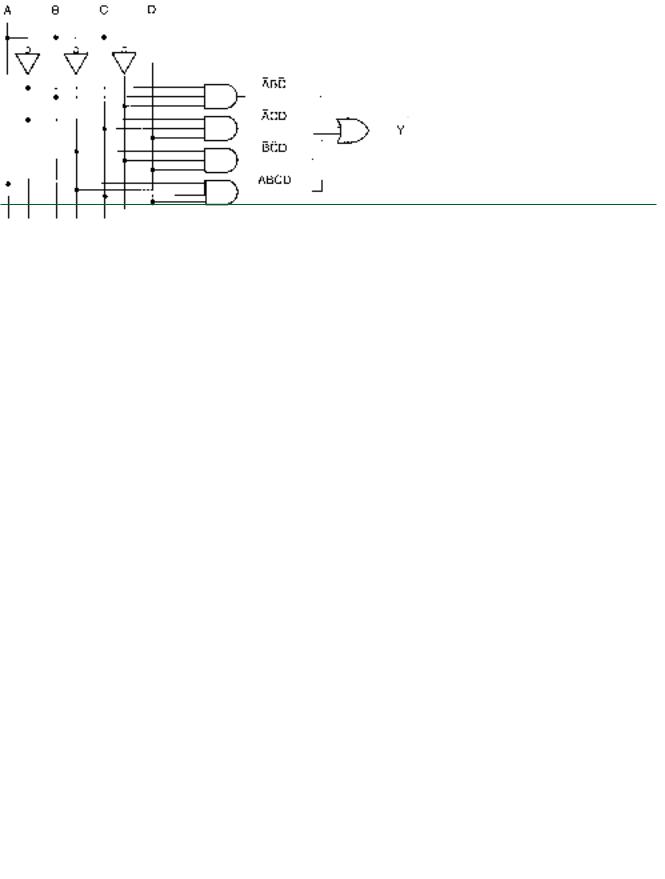
3.5 • Simplification by the Karnaugh Map Method |
99 |
FIGURE 3.52
Simplified Circuit
EXAMPLE 3.20 |
Use a Karnaugh map to find the maximum SOP simplification of the circuit shown in |
|
Figure 3.53. |
FIGURE 3.53 |
|
Example 3.20 |
|
Circuit to Be Simplified |
|
Solution Figure 3.54a shows the Karnaugh map of Figure 3.53 with terms grouped as shown in the original circuit. Figure 3.54b shows the terms regrouped for the maximum simplification, which is given by:
Y A D B D A B C
Alternate method: The Boolean expression for the circuit in Figure 3.53 is:
Y A B C A C D B C D A B C D
FIGURE 3.54
Example 3.20
Maximum Simplification of
Figure 3.53
